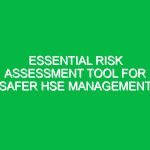Introduction
Risk controls are systematic methods implemented to minimize, monitor, and mitigate risks associated with health, safety, and environmental (HSE) management. In today’s fast-paced industrial landscape, where operations range from construction sites to chemical plants, understanding and implementing effective risk controls is not just a regulatory requirement but a moral imperative. The significance of these controls cannot be overstated; they protect employees, ensure compliance with laws, enhance organizational reputation, and ultimately contribute to Sustainability efforts.
As industries evolve, so do the complexities of risks associated with them. This article delves into the essential risk controls that organizations can adopt for effective HSE management. By exploring the various types of risk controls, their implementation, and the regulatory frameworks that govern them, we aim to provide a comprehensive understanding of how to manage risks effectively.
Understanding Risk Controls in HSE
Risk controls can be categorized into several types. Each type plays a critical role in maintaining a safe and healthy work Environment while ensuring compliance with environmental Standards. Below are the primary categories of risk controls that organizations should consider:
1. Engineering Controls
Engineering controls involve the design and Maintenance of equipment or processes to reduce exposure to Hazards. Examples include:
- Isolation: Keeping hazardous processes away from workers (e.g., using guardrails or Safety enclosures).
- Ventilation: Implementing proper ventilation systems to reduce airborne contaminants.
- Machine Safeguarding: Installing Safety devices on machinery to prevent accidental injuries.
These controls are often the most effective at reducing risk, as they do not rely on human behavior but rather on physical changes to the work environment.
2. Administrative Controls
Administrative controls involve policies, procedures, and practices that govern how work is performed. These controls include:
- Training Programs: Regular Training sessions to educate employees about safety practices and hazard recognition.
- Standard Operating Procedures (SOPs): Detailed instructions for carrying out tasks safely and efficiently.
- Job Rotation: Rotating employees through different tasks to minimize prolonged exposure to Hazards.
While administrative controls can significantly enhance safety, they require constant management and oversight.
3. Personal Protective Equipment (PPE)
PPE is the last line of defense against workplace hazards. It includes items such as helmets, gloves, goggles, and respirators. Proper use of PPE is essential, and organizations must ensure that workers are trained to use it correctly. Here are some critical considerations:
- Selection: Choosing the right PPE based on the specific hazards present in the workplace.
- Maintenance: Regularly inspecting and maintaining PPE to ensure it remains effective.
- Compliance: Enforcing policies that require PPE use when necessary.
While PPE is crucial, it should be viewed as a supplementary measure rather than a primary control method.
Implementing Effective Risk Controls
Implementing risk controls in the HSE context requires a systematic approach. Here are steps organizations can follow to ensure the effectiveness of their risk controls:
1. Risk Assessment
Before implementing risk controls, it is essential to conduct a thorough risk assessment. This involves identifying potential hazards, assessing the risks associated with these hazards, and determining the necessary Control Measures. Risk assessment should be a continuous process, with regular reviews and updates.
2. Prioritization of Controls
Not all risks are created equal. Organizations need to prioritize which risks to address based on their severity and likelihood of occurrence. This prioritization can help allocate resources more effectively and address the most critical risks first.
3. Development of Control Measures
Based on the risk assessment and prioritization, organizations should develop control measures tailored to their specific needs. This may involve a combination of engineering controls, administrative controls, and PPE. Engaging employees in this process can lead to better buy-in and more effective implementation.
4. Training and Communication
Once control measures are in place, it is vital to train employees on their roles and responsibilities regarding these measures. Clear communication about the importance of risk controls and how to implement them can foster a culture of safety within the organization.
5. Monitoring and Review
Effective risk controls require ongoing monitoring and review. Organizations should regularly assess the effectiveness of their control measures and make adjustments as needed. This can include analyzing incident reports, conducting safety audits, and soliciting feedback from employees.
Benefits of Effective Risk Controls
Implementing effective risk controls provides numerous Benefits:
- Improved Safety: A well-structured risk control system significantly reduces the likelihood of accidents and injuries.
- Regulatory Compliance: Adhering to legal requirements helps avoid fines and legal issues.
- Enhanced Reputation: Companies known for prioritizing safety attract better talent and customers.
- Operational Efficiency: Reducing incidents leads to less downtime and improved productivity.
Real-life examples illustrate the importance of these benefits. For instance, in 2010, BP’s Deepwater Horizon disaster resulted in catastrophic loss of life and environmental damage, primarily due to inadequate risk controls. Conversely, organizations that prioritize safety often report higher employee satisfaction and retention rates, as seen in companies like DuPont, which has a long-standing commitment to HSE management.
Regulations and Standards Governing Risk Controls
Understanding the regulatory landscape is crucial for effective risk controls. Various Regulations and standards govern HSE practices, including:
1. OSHA Standards
In the United States, the Occupational Safety and Health Administration (osha) sets and enforces standards to ensure safe working conditions. OSHA regulations cover a wide range of industries and provide guidelines for implementing effective risk controls.
2. ISO 45001
ISO 45001 is an international standard for Occupational Health and safety management systems. It provides a framework for organizations to improve employee safety, reduce workplace risks, and create better working conditions.
3. Environmental Regulations
In addition to health and safety regulations, organizations must also adhere to environmental regulations. The Environmental Protection Agency (EPA) and equivalent bodies in other countries enforce standards that protect the environment from industrial hazards.
Understanding these regulations helps organizations align their risk controls with legal requirements, ensuring compliance and promoting a culture of safety and responsibility.
Conclusion
In conclusion, effective risk controls are vital for maintaining health, safety, and environmental standards in any organization. By understanding the components of risk controls, implementing them systematically, and adhering to regulatory guidelines, organizations can significantly reduce risks associated with workplace hazards. The benefits of such controls extend beyond compliance; they foster a culture of safety, enhance operational efficiency, and protect the organization’s most valuable asset—its people.
As industries continue to evolve, it is crucial to remain vigilant and proactive in managing risks. Organizations should continuously assess their risk control measures and adapt to emerging challenges. By doing so, they not only comply with regulations but also contribute to a safer and more sustainable future for all.


